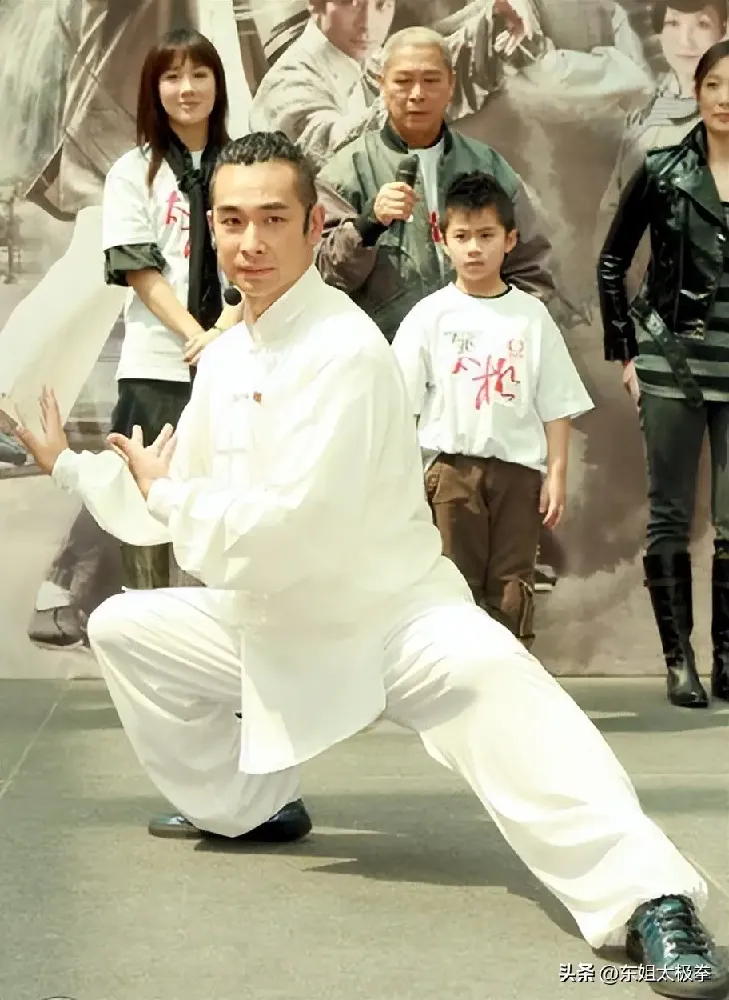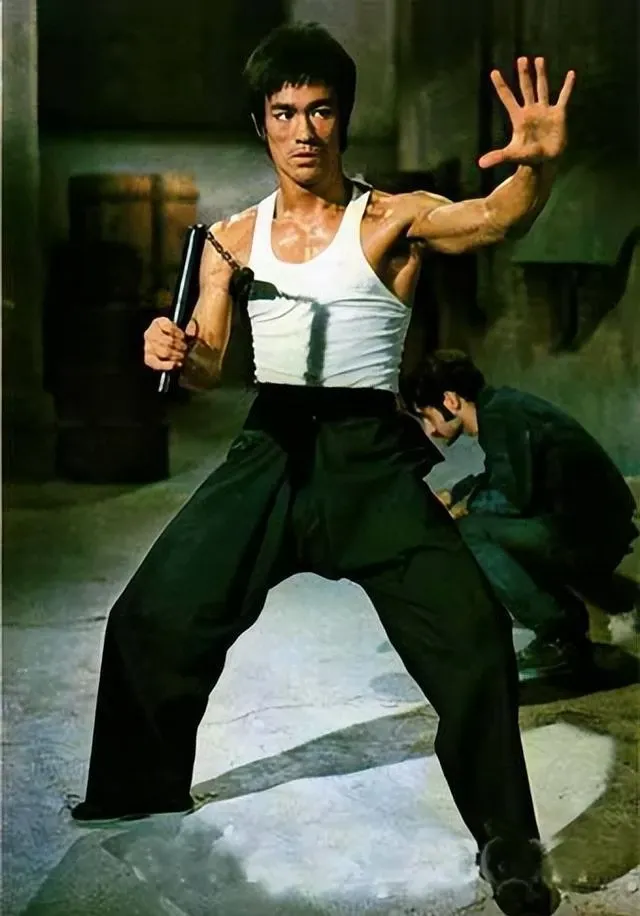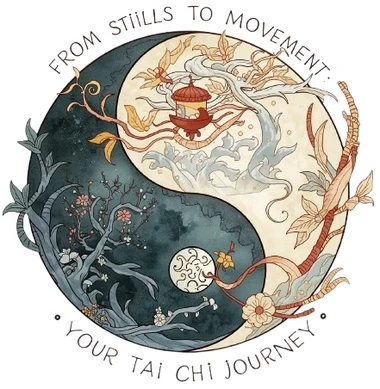Your First Step into Wushu: More Than Flips and Fancy Swords
Ever watch a Wushu performance and feel your heart race? The practitioner soars through the air, a human whirlwind of power and grace. A gleaming sword cuts through the space, an extension of their will. It's easy to think, "That's incredible, but I could never do that."
We've heard that countless times from new students at Tai Chi Wuji. Here's a little secret: those breathtaking feats aren't the starting point. They are the destination of a truly transformative journey. This Chinese martial art is for everyone. It’s a path of self-discovery, and every path begins with a single, grounded stance. Consider this your friendly guide to that first step.
Many people ask us, "Is Wushu the same as Kung Fu?" It's a great question. Think of it this way: "Kung Fu" (or Gong Fu) can refer to any skill achieved through great effort, like mastering calligraphy or even making perfect tea.
Wushu, however, is the specific term for the organized system of Chinese martial arts. It's the official umbrella that covers everything from the explosive, acrobatic moves you see in movies to the internal, meditative practices.
So, while all Wushu can be called Kung Fu in a broad sense, not all Kung Fu is the structured practice of Wushu. Understanding this distinction helps you see the true depth and organization of this physical art.
You might also wonder, "Is Wushu a real martial art?" or "Is it even effective?" The answer is a resounding yes, but with a key insight. The modern practice of Wushu has two beautiful, complementary sides: the artistic performance of Taolu (forms) and the practical combat of Sanda (sparring). One is the "song" of martial arts, the other is the "conversation."
At Tai Chi Wuji, we believe you don't have to choose just one. Exploring both gives you a complete picture of what your body and mind can achieve.

So, What Exactly Is Wushu? Let's Break It Down.
Forget the complex definitions for a moment. At its core, Wushu is the art of moving your body with intention, power, and awareness. The word itself translates to "martial art" ("Wu" for military, "Shu" for art). But this isn't just about fighting. It's about cultivating a strong spirit and a capable body. It’s a moving meditation that builds incredible fitness.
This practice didn't appear overnight. Its origins are woven into thousands of years of Chinese history. It evolved from ancient battlefield techniques and self-defense methods. Over centuries, it absorbed philosophical principles and became a way to train the mind and character.
The modern Wushu we teach today standardizes these ancient traditions into a system that anyone, anywhere, can learn. It preserves the soul of the old masters while making it accessible for the modern student.
The Two Sides of the Coin: Your Wushu Journey Awaits
When you step into our academy, you'll discover that Wushu isn't a single thing. It's a rich tapestry of disciplines. To make it simple, we focus on two main pillars that give you the full, exhilarating experience.
Taolu – Become the Artist of Your Own Movement
Imagine your body is a paintbrush and the space around you is a canvas. Taolu is the art of painting a powerful, elegant picture with your movements. These are pre-arranged sequences of techniques, known as forms.
They include attacks, blocks, stances, and yes—those amazing jumps and acrobatics.
We start all our beginners with the fundamentals. You'll learn stances that root you to the ground like a tree. You'll practice basic strikes and blocks, building a solid vocabulary of motion. A common misconception is that you need to be super flexible to start.
Not true! We believe in "structure before stretch." A powerful, stable horse stance is far more valuable than a shaky, forced split. Flexibility will come with consistent, patient practice.
This foundational training is one of the key benefits of Wushu for beginners, building a body that is both resilient and capable.
Sanda – The Practical Language of Self-Defense
Now, let's talk about the other side: Sanda (also called Sanshou). If Taolu is the poetry of Wushu, Sanda is the gritty, honest conversation. This is the full-contact fighting system. It answers the question, "Can Wushu be used for self-defense?" with a powerful yes.
Sanda integrates punches, kicks, and—something many don't realize—throws and sweeps. That's right, Wushu does include grappling.
It's a complete and highly effective stand-up fighting style. Don't believe anyone who says it's only for show.
In our Sanda classes, the first thing we teach isn't how to hit hard. It's how to fall safely. Learning to receive a throw without getting hurt is a priceless skill that builds confidence and dispels fear.
This makes learning practical Wushu for self-defense a realistic and empowering goal from day one.

More Than Kicks and Punches: The Gifts Wushu Gives Your Body and Mind
Let's get practical. You're probably thinking, "This sounds cool, but what's in it for me?" The rewards of a consistent Wushu practice go far beyond the training hall. It’s a total package for personal transformation. You won't just learn how to throw a punch; you'll learn how to carry yourself through life with more grace and confidence.
Think about your current workout. Maybe it feels like a chore. Wushu training flips that script. It turns fitness into an adventure. Every class is a full-body challenge. You'll build lean, functional strength from holding deep stances.
Your flexibility will skyrocket as you safely stretch into new poses. Your cardiovascular endurance will get a major boost from the dynamic drills.
And your coordination? It will reach levels you didn't know were possible. This isn't just exercise; it's skill-building. You're not just counting reps; you're mastering the art of movement.
The mental and emotional benefits of learning a martial art like Wushu are just as powerful. In our fast-paced world, your mind is constantly pulled in a dozen directions. Wushu demands your full attention.
When you're focusing on the precise angle of your hand and the flow of your breath, there's no room to worry about your inbox. This intense focus becomes a form of moving meditation. It washes away stress and sharpens your clarity. You walk out of the studio feeling physically tired but mentally reset. It’s your active antidote to a sedentary, stressful life.

Your Toolkit: From Bare Hands to Legendary Weapons
One of the most exciting parts of starting Wushu is discovering its incredible variety. It’s a vast playground for physical expression. You begin with the most important tool you own: your body.
The Foundation: Your Own Two Feet (and Fists!)
Your journey starts with empty-handed forms, or Taolu. We guide you through styles like Changquan (Long Fist), known for its graceful, extended movements and athletic jumps.
It’s the style that often comes to mind when people think of modern Wushu. But there's also the power-packed Nanquan (Southern Fist), which focuses on strong, stable stances and powerful arm techniques.
And let's not forget Taijiquan—yes, the slow, flowing Tai Chi you might see in parks is a vital part of the Wushu family, teaching profound lessons about balance, relaxation, and internal energy.
Unleash Your Inner Hero: An Introduction to Wushu Weapons
Now for the really fun part! Once you have a solid foundation, you might get to try a Wushu weapon. This is where the art truly comes alive for many students.
It’s not about violence; it’s about partnership. You learn to make the weapon an extension of your own body.
- The straight, double-edged Jian (Sword) is the "gentleman of weapons." It teaches finesse, precision, and elegant control.
- The curved Dao (Broadsword) is the "general of weapons." Its practice is bold and powerful, full of sweeping, aggressive movements.
- The Gun (Staff) is the "grandfather of all weapons." Learning to spin, thrust, and sweep with a long staff builds incredible coordination and whole-body power.
A question we often get is, "Why are Wushu swords so floppy?" Great observation! The表演 (biaoyan - performance) weapons used in modern Taolu are light and flexible. This isn't for combat; it's for aesthetics.
The flexibility creates a satisfying "whoosh" and a dazzling shimmer in the light, making the performance more dynamic and visually stunning. It’s a tool for art, just like a dancer's ribbon.

Ready to Start? Your Roadmap to a Great Wushu Class
Feeling inspired? Let's talk about how you can take that inspiration and turn it into action. Starting something new can be daunting, but it doesn't have to be complicated.
First, finding the right school is crucial. Look for a qualified Wushu academy or coach with experience teaching adults. Read reviews and, most importantly, visit for a trial class. The vibe of the school and the coach's teaching style should feel supportive and encouraging.
At Tai Chi Wuji, we prioritize a positive, non-intimidating environment because we know a scared student is a stagnant student.
Don't worry about gear upfront. For your first classes, you just need comfortable workout clothes and a water bottle. If you stick with it, you might invest in a pair of flat Wushu shoes for better grip and a traditional uniform. But that can come later.
The only essential equipment at the beginning is your willingness to learn and a good attitude.
Finally, check out the global Wushu community. Look up videos of the World Wushu Championships to see the art at its highest level. Follow the work of the International Wushu Federation (IWUF). Seeing the global passion for this art can be incredibly motivating as you begin your own personal journey with Chinese martial arts.
Wushu in the Wild: From the Big Screen to the Olympic Dream
So, is Wushu just a practice for the training hall? Far from it. Its influence is everywhere in modern culture.
You've probably seen its dynamism in blockbuster movies. Actors like Jet Li and Jackie Chan, with their deep Wushu backgrounds, brought a new level of athletic grace and complex choreography to Hollywood action films. This exposure made Chinese martial arts a global phenomenon.
But what about the world of sports? A common question we hear is, "Is Wushu an Olympic sport?"
Not yet, but it's knocking on the door. The International Wushu Federation (IWUF) is actively campaigning for its inclusion.
Wushu has already been featured in events like the Youth Olympics and the Asian Games. The global Wushu community is growing fast, with thrilling competitions held worldwide, from the USA Wushu Collegiates to the World Wushu Championships.
This isn't a hidden art; it's a living, breathing, and globally recognized sport.
Let's break down its cultural footprint with a quick list. You can find Wushu's spirit in:
- Action Cinema: The core of many classic fight scenes in films like Crouching Tiger, Hidden Dragon.
- Video Games: Characters and combat styles in games like Age of Wushu and Mortal Kombat.
- Social Media: Viral clips of stunning Wushu performances and tutorials from athletes worldwide.
- International Sport: A recognized discipline in multi-sport games, governed by a formal federation.
Straight Talk: Your Top Wushu Questions, Answered
Let's cut through the noise and tackle the questions that every beginner has. This isn't about complex theory; it's about giving you clear, honest answers.
Q: I'm not flexible or in great shape. Is Wushu too hard for me?
This is our most frequent concern. The answer is no—it's for you because you want to improve. Everyone starts somewhere. We build your fitness and flexibility progressively, safely, and at your pace. The challenge is part of the fun!
Q: Okay, but for real—is Wushu actually effective in a fight?
This is a crucial distinction. The artistic Taolu is for performance and physical mastery. However, Sanda is the direct, practical combat system. It is a proven and effective stand-up fighting style that includes:
- Powerful punching and kicking combinations.
- Clinch work and takedowns.
- Defensive maneuvers and footwork.
- Throws and sweeps from traditional Chinese wrestling.
So, for real-world self-defense skills, Sanda is incredibly effective.
Q: Does Wushu have a belt ranking system?
It varies. The traditional Chinese system uses a "Duan" or level system (e.g., 1st Duan, 2nd Duan).
Many Western schools have adopted colored sashes or belts to help students mark their progress.
The key is consistent grading and clear goals, which any good school will provide.
Let's simplify the path to getting started. To find your perfect Wushu class, you should:
- Search Online: Use terms like "Wushu classes near me" or "Wushu academy."
- Check Credentials: Look for coaches certified by national federations.
- Read Reviews: See what other students say about the atmosphere and teaching.
- Take a Trial Class: This is the most important step. Experience the vibe yourself.
- Ask Questions: Talk to the coach about your goals and their approach for beginners.
Wushu Core Information Table
| Aspect | Taolu (Forms) | Sanda (Sparring) |
|---|---|---|
| Primary Focus | Aesthetic expression, perfect form, artistic flow | Combat efficiency, practical application, fighting skills |
| Training Content | Pre-arranged movement sequences, weapon routines, flexibility | Punching, kicking, throwing techniques, defense maneuvers |
| Expression Format | Individual or group performance judged on technical merit | Competitive fighting in a lei tai (platform) with points |
| Main Objective | Perfect execution of techniques with grace and power | Effectively strike or take down opponent within rules |
| Best For | Those seeking artistic expression, flexibility, and body control | Those interested in self-defense, combat sports, and practical skills |
| Comparison | The "poetry" of martial arts | The "conversation" of combat |
Your Journey Begins Now: Embrace the Way of Wushu
We've traveled from the ancient origins of Wushu in China to its modern-day presence on the global stage.
We've unpacked its two hearts: the artistic beauty of Taolu and the raw, practical power of Sanda.
We've seen how it forges not just a stronger body, but a sharper, more resilient mind.
This isn't about becoming a movie stuntman or an undefeated fighter. It's about becoming a better, more capable version of yourself.
The philosophy of Wushu teaches us that mastery lies in the journey, not just the destination. Every perfected stance, every new stretch, every ounce of confidence gained is a victory. It connects you to a rich cultural history while giving you the tools to navigate modern life with more grace and power.
So, what are you waiting for? The path is right in front of you. Finding a qualified Wushu instructor is your first step into this incredible world. Let your curiosity outweigh your hesitation. Take that trial class. Feel the energy of the studio.
Your journey toward strength, confidence, and a deeper connection with your body is calling. How will you answer?
FAQ
What exactly is Wushu and how does it differ from traditional Kung Fu?
Wushu represents the modern evolution of Chinese martial arts, systematically organized for both competitive sport and personal development. While "Kung Fu" refers broadly to any skill achieved through dedication, Wushu specifically denotes the structured practice of Chinese martial arts with standardized training methods and competition rules.
Can Wushu training actually prepare me for real self-defense situations?
Absolutely. While the beautiful Taolu forms emphasize artistic performance, Wushu Sanda provides comprehensive combat training that includes: Powerful striking combinations using fists and feet Practical throwing and takedown techniques Effective defensive maneuvers and footwork Realistic sparring practice against resisting opponents
What weapons are typically used in Wushu training for beginners? Beginners usually start with these fundamental weapons:
Staff (Gun) - Foundation for all long weapons Broadsword (Dao) - Curved saber for powerful cuts Straight Sword (Jian) - Double-edged sword requiring precision Spear (Qiang) - Flexible weapon teaching coordination and control
How does progression work in Wushu - is there a belt system? Wushu uses multiple progression systems:
Duan Wei System - Official level system from 1st to 9th Duan Color Sashes/Belts - Used internationally for beginner through advanced levels Competition Categories - Divided by age, gender, and skill level Skill Accreditation - Official certifications for coaching and judging
What makes Wushu different from other popular martial arts like Taekwondo or Karate? Wushu stands out through its:
Unique combination of traditional Chinese martial arts with modern sports science Equal emphasis on both artistic forms (Taolu) and practical combat (Sanda) Extraordinary emphasis on flexibility, acrobatics, and dynamic movements Deep connection to Chinese cultural philosophy and aesthetics Comprehensive approach developing all aspects of physical fitness
I'm not very flexible - can I still practice Wushu effectively? Definitely! Wushu training systematically improves flexibility through:
Progressive stretching routines designed for all levels Specialized exercises targeting martial arts flexibility Safe techniques that respect your current physical limitations Personalized adjustments based on your body type and goals
What should I look for when choosing a Wushu school or instructor? Key factors to consider include:
Instructor credentials and competition experience School atmosphere and teaching methodology Balance between Taolu and Sanda in the curriculum Safety protocols and training equipment quality Student progression system and competition opportunities
How does Wushu contribute to overall health and wellness? Regular Wushu practice provides exceptional benefits:
Complete full-body conditioning and cardiovascular improvement Enhanced flexibility, balance, and body coordination Stress reduction through focused movement meditation Development of discipline, confidence, and mental resilience Community connection through shared training experiences
